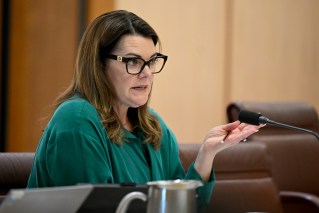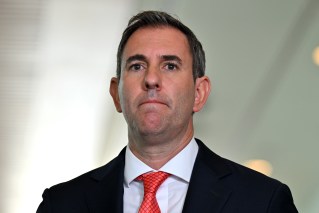Coalition’s advance stops dead as Labor inches closer to victory in latest Roy Morgan poll

After making advances early in this election campaign, the Coalition’s momentum appears to have stalled as Labor’s underlying lead grows and early voting begins.
With less than two weeks until the election, this week’s Roy Morgan poll shows the ALP enjoying a hefty nine-point advantage in two-party preferred terms, a gain of 0.5 points from last week.
That would be a decisive, election-winning lead.
But the data also points to an increasingly complicated national politics as a record proportion of voters did not declare an intention to vote for a major party, a shift that makes predicting parliament’s composition difficult.
Using a new method for allocating preferences employed from this week, the Opposition is now up on the Coalition by 54.5 to 45.5 per cent.
The poll is the first taken since the Reserve Bank of Australia raised interest rates in the middle of a campaign with a heavy focus on the cost of living.
The ALP’s share of the primary vote, or underlying support, also rose slightly by 0.5 points to reach 35.5.
After being tied, the Opposition has now drawn ahead of the Coalition, whose vote has fallen by 1 point to 34 per cent.
The poll sheds light on declining voter support for the major parties as attention continues to centre on what role independent challengers might play in the national poll.
A total of 7 per cent of voters surveyed this week could not say who would receive their support at an election, a figure unchanged from a week earlier.
When these voters are added to the overall primary vote estimate, people supporting either a minor party, independent candidate or who cannot, or will not say, rises to 35.5 per cent – more than the readjusted support for either major party.
“This large cohort of voters not voting for their major parties makes predicting the final two-party preferred result particularly difficult and increases the chances of a large number of cross-benchers being elected,” said Roy Morgan chief executive officer Michele Levine.
“On current trends, the ALP will win a majority of seats at the federal election and any cross-benchers elected will not hold the balance of power.
“A late swing to the L-NP over the last two weeks of the election campaign could still produce a hung Parliament with the ALP favoured to be able to form government.”
This week’s Roy Morgan poll interviewed 1401 Australian voters through a mix of telephone and internet surveys from May 2 to May 8.
A sample of this size has a margin of error of 3 per cent.
Support for the Greens is unchanged at 13 per cent.
One Nation recorded a 1 point gain to its vote share of 4 per cent; support for the United Australia Party is unchanged at 1 per cent.
The proportion of voters intending to back Other Parties rose by 0.5 points to 4 per cent and overall support for independents fell to 8.5 per cent, a one-point decline.
Labor is in pole position in four states, while the Coalition is in front in Queensland and Tasmania.
Ms Levine says the Opposition are firmly favoured to form government after the election.
“The L-NP made a late surge three years ago and increased their two-party preferred vote by 2.5 percentage points over the last two weeks of the campaign,” she said.
“A similar swing for the L-NP now would not be enough.”
Polls open
The slight growth in Labor’s lead comes after last week’s decision by the Reserve Bank of Australia to raise interest rates by 0.25 per cent: The first such rise during an election campaign in nearly 15 years.
It also comes as a large proportion of voters begin to focus their minds on the question of who to support at the election.
Pre-polling opened on Monday and the number of people casting their ballot on the first day grew considerably.

Monday was the first day of pre-poll voting at more than 500 locations across the country.
According to a statement by the Australian Electoral Commission, some 280,000 people voted on the opening day of pre-polling, far more than the 120,000 who did so in the 2019 election.
Blazing the trail
After a showing at a pre-election debate criticised by some for being too argumentative, the polls’ opening seemed to give both party leaders a new sense of urgency.
Labor leader Anthony Albanese had been criticised for not matching the pace set by Prime Minister Scott Morrison as reporters questioned whether he was suffering from the after-effects of his COVID-19 illness.
On Monday, though, he set a cracking pace as Labor’s campaign made its way through three seats.
Mr Morrison was on the New South Wales south coast and in the division of Gilmore, a seat that the Coalition felt it should not have lost at the previous election, after a blazing internal row over the installation of Warren Mundine as a hand-picked candidate.
The high-profile former state transport minister Andrew Constance is well known for his criticism of the Prime Minister’s handling of the Black Summer bushfires and, party strategists believe, has a strong chance of claiming the seat currently on a margin of just over 2.5 per cent.
New model
This week’s survey adopts a new model for estimating the flow of voters’ preferences, the calculation that feeds into the overall measure of two-party preferred support.
Roy Morgan’s calculations have previously relied on voters’ declarations of where they intend to direct their preferences.
The poll will now instead allocate preferences according to how they flowed at the last federal election.
Analysis shows a gap between voters’ pre-election preference indications and the support they declare on their ballots on election day.
Historically, using voters’ statements as the basis for preference allocations adds to Labor’s two-party preferred vote by between 1 and 2 percentage points.
When applied to this week’s data, allocating preferences according to voters statements does not change the big picture finding: A resounding ALP lead in two-party preferred terms increasing by 0.5 per cent.
It does reduce the size of Labor’s estimated lead, which, on previous calculations, would have this week stood at 12 per cent, or 56 to 44 in two-party preferred terms.








